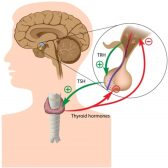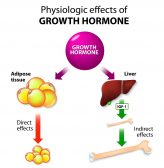Definition
noun, plural: estrogens
A sex steroid hormone produced in large quantities chiefly in the ovaries in females; when bound to estrogen receptors, becomes active so that, in females, produce effects that are essential for the development and the maintenance of secondary female sexual characteristics as well as in the regulation of the changes in the female reproductive cycle and in pregnancy maintenance
Supplement
Estrogen is one of the major classes of sex steroids (or sex hormones) of vertebrates, including humans. It is also synthesized naturally by certain insects. Other sex steroids include androgens and progestogens. Estrogens are generally considered as the female sex hormones. That is because the estrogens are responsible for the development and the maintenance of secondary female sexual characteristics in females at puberty.
The term estrogen is a generic term for estrus-producing steroid compounds. It is also referred to as the female sex hormones because it is responsible for the development and the maintenance of the female secondary sex characteristics. It also acts on the female genitalia to produce an environment suitable for fertilization, implantation, and nutrition of the early embryo. Thus, it is essential during the menstrual cycle in females. It is also vital during pregnancy maintenance. Apart from the reproductive functions, it also has an anabolic effect on protein metabolism and water retention.
The estrogen is also produced in males (possibly in the adrenal cortex and the testes) but in very low amounts. In females, it is produced in large amounts beginning at puberty. It is produced mainly in the ovaries and in the foetoplacental unit during pregnancy. Follicle-stimulating hormone (FSH) stimulates the ovaries to produce estrogens.
The biosynthesis of estrogens begins when cholesterol is metabolized to produce estrogens as the end product through series of enzymatic steps of steroidogenesis. In females, the process starts in the theca interna cells of the ovaries. Here, the cholesterol goes through steps that lead to the production of andostenedione. The andostenedione, then, crosses the basal membrane to reach the granulosa cells where it will be converted either into estrogen (particularly, into estrone and estradiol) or into testosterone. The testosterone can later be converted into estradiol by another enzymatic step using aromatase, an enzyme in granulosa cells that catalyzes the conversion of testosterone into estradiol.
Other tissues that produce estrogens are liver, pancreas, skin, bone, brain, adrenal glands, fat tissues, and breasts.
The four major estrogens are estrone (E1), estradiol (E2), estriol (E3), and estetrol (E4). In humans, the quantity of estrogens is lower than that of androgens in the bloodstream. Like the other steroid hormones, the circulating estrogens are bound to the albumin and/or sex hormone-binding globulin. They can diffuse through the cell membrane of the target cell. Then, they lose the globulin or albumin to bind with the estrogen receptors on the nucleus so that they can regulate the expression of certain genes.
Synthetic estrogens are used as medications. They are used in oral contraceptives and as a palliative in cancer of the breast after menopause and cancer of the prostate, other uses include the relief of the discomforts of menopause, inhibition of lactation and treatment of osteoporosis, threatened abortion and various functional ovarian disorders.
Word origin: Greek andr– (“main”)
Variant(s):
- oestrogen (British)
See also:
Related term(s):
- Esterified oestrogens
- Non-steroidal oestrogens
- Oestrogens catechol
- Oestrogens conjugated
- Oestrogens synthetic
- proestrogen
Related form(s):





